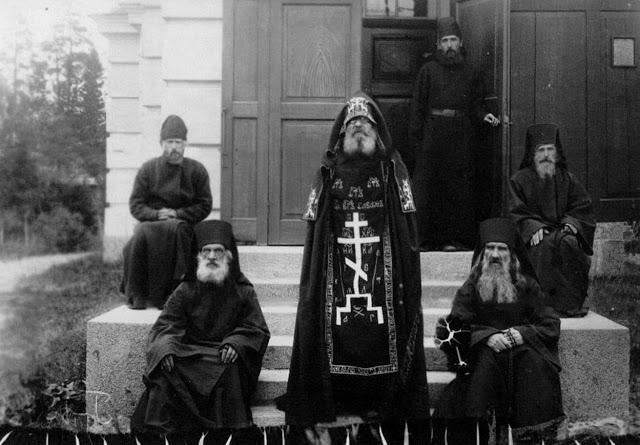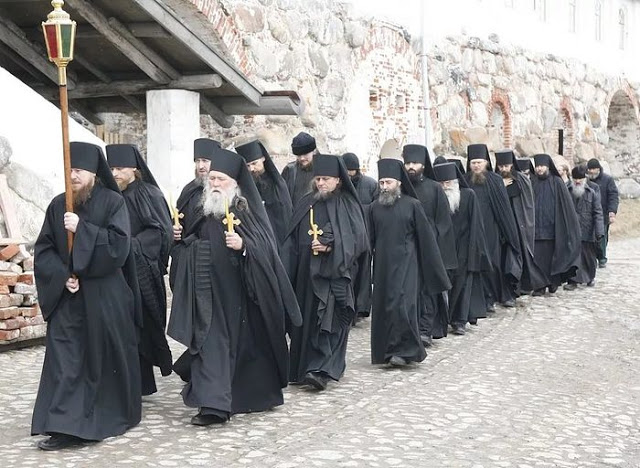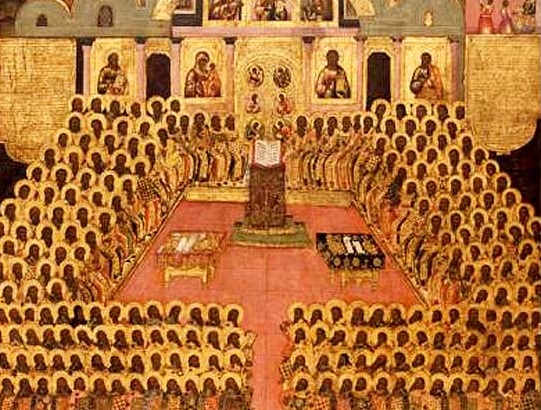
Although the Orthodox Church does not have religious orders as the Latin (Roman Catholic) church does, there are different styles of monastic life in Orthodoxy, both individually and in community. Generally speaking some monasteries may be more liturgical oriented, while others may be mores ascetic, while still other may have a certain mystical tradition, and other be more inclined to spiritual guidance and openness to the world for the purpose of care and counseling. These various styles of monasticism, which take both a personal as well as a corporate form, are not formally predetermined or officially legislated. They are the result of organic development under the living grace of God.
In addition to the various spiritual styles of monastic life, three formal types of organization may be mentioned. The first is that of coenobitic communion. In the coenobitic monastery everything is shared: living quarters, food, work, prayer, common efforts, cares, struggles, and achievements. The leader and spiritual father of the coenobium is the Abbot (Egoumenos). The exhortation to the Abbot in the Charter of St. Athanasius the Athonite is typical: “Take care that the brethren have everything in common. No one must own as much as a needle. Your body and soul shall be your own, and nothing else. Everything must be shared equally with love between all your spiritual children, brethren and fathers.” The second form is called idiorhythmic in which the monks or nuns pray together liturgically, but work and eat individually or in small groups. In this type of monasticim the persons may even psalmodize and do the offices separately, coming together only for the Eucharistic Liturgy, and even then, perhaps, only on certain occasions. Finally, there is the eremitic type of monasticism where the individual monks or nuns are actually hermits, also called anchorites or recluses. They live in total individual seclusion and never join in the liturgical prayer of the community, except again perhaps on the most solemn occasions. In the rarest of cases it may even happen that the holy Eucharist is brought to the monk or nun who remains perpetually alone.

The Monastic Ranks
The Orthodox monastic tradition has four classic ranks that apply equally to men and women. The first step is that of novice (Greek:δόκιμος), which in church terminology is called the rank of obedience. At this first stage the candidate for monastic profession simply lives in the monastery under the direction of a spiritual father or mother. There is no formal ceremony for the clothing of a novice, he or she simply receives permission to wear the clothing of a novice. In the Eastern monastic tradition, novices, may or may not dress in the black inner cassock (Greek: Anterion [Αντερίον], Esorason [Εσώρασον], Slavonic: Podriasnik) and wear the soft monastic hat (Greek: Skoufos, Slavonic:Skufia), depending on the tradition of the local community, and in accordance to the Abbot’s directives. In some communities, the novice also wears the leather belt. Monks are given a prayer rope and instructed in the use of the Jesus Prayer.
If a novice chooses to leave during the period of the novitiate, no penalty is incurred. He may also be asked to leave at any time if his behavior does not conform to the monastic life, or if the superior discerns that he is not called to monasticism. When the Abbot or Abbess(Egoumenos or Egoumenissa) deems the novice is ready, he is asked if he wishes to join the monastery. Some, out of humility, will choose to remain novices all their lives. Every stage of the monastic life must be entered into voluntarily.
Rasophore (Greek: ρασοφόρος, rasophoros; Slavonic: ryasofor), lit. “Robe-bearer”– If the novice continues on to become a monk, he is clothed in the first degree of monasticism at a service at which he receives the tonsure. Although there are no formal vows made at this point, the candidate is normally required to affirm his commitment to persevere in the monastic life. The Abbot (Egoumenos) will then perform the tonsure, cutting a small amount of hair from four spots on the head, forming a cross. He is then given the outer robe with wide sleeves, fromwhich the name Rassophoros is derived. He is also given a kamilavkion, a cylindrical brimless hat, which is covered with a veil called an epanokamelavkion. (These are separate items in the Greek tradition; in the Russian tradition the two are stitched together and collectively called a klobuk.) If he has not previously received it, a leather belt is fastened around his waist. His habit is usually black, signifying that he is now dead to the world and he receives a new name.
Although the Rassophoros does not make formal vows, he is still morally obligated to continue in the monastic estate for the rest of his life. Some will remain Rossophoroi permanently without going on to the higher degrees.

Stavrophore (Greek: σταυροφόρος, stavrophoros; Slavonic: krestonosets), lit. “Cross-bearer”— The next level for Eastern Orthodox monastics takes place some years after when the Abbot (Egoumenos) feels the monk has reached an appropriate level of discipline, dedication and humility. This degree is also known as the Little Schema, and is thought of as a “betrothal” to the Great Schema. At this stage, the monk makes formal vows of stability of place, chastity, obedience and poverty. Then he is tonsured and clothed in the habit, which in addition to that worn by the Rassophoroi, include the paramandyas (Greek: παραμανδύας; Slavonic: paraman), a piece of square cloth worn on the back, embroidered with the instruments of the Passion, and connected by ties to a wooden cross worn over the heart. The paramandyas represents the yoke of Christ. Because of this addition he is now called Stavrophoros, or Cross-bearer. He is also given a wooden hand cross (or “profession cross”), which he should keep in his icon corner, and a beeswax candle, symbolic of monastic vigilance the sacrificing of himself for God. He will be buried holding the cross, and the candle will be burned at his funeral. In the Slavonic practice, the Stavrophore also wears the monastic mantle, which symbolizes 40 days of the Lord’s fasting on the Mountain of Temptation. The rasson worn by the Stavrophore is more ample than that worn by the Rassophore.
After the ceremony, the newly-tonsured Stavrophore will remain in vigil in the church for five days, refraining from all work, except spiritual reading. Currently, this vigil is often reduced to three days. The Egoumenos (Abbot) increases the Stavrophore monk’s prayer rule, allows a more strict personal ascetic practice, and gives the monk more responsibility.
Great Schema
Great Schema (Greek: μεγαλόσχημος, megaloschemos; Slavonic: Schima)–Monks whose Egoumenoi (Abbots) feel they have reached a high level of spiritual excellence reach the final stage, called the Great Schema. The tonsure of a Schemamonk or Schemanun follows the same format as the Stavrophore, and he makes the same vows and is tonsured in the same manner. But in addition to all the garments worn by the Stavrophore, he is given the analavos (Slavonic: analav) which is the article of monastic vesture emblematic of the Great Schema. For this reason, the analavos itself is sometimes itself called the “Great Schema.” It drapes over the shoulders and hangs down in front and in back, with the front portion somewhat longer, and is embroidered with the instruments of the Passion and the Trisagion (i.e., the Cross of Calvary, spear, reed, sponge, skull and Adam’s cross-bones and Peter’s cock.) The Greek form does not have a hood, the Slavonic form has a hood and lappets on the shoulders, so that the garment forms a large cross covering the monk’s shoulders, chest, and back. Another piece added is the Polystavrion (Πολυσταύριον, “Many Crosses”), which consists of a cord with a number of small crosses plaited into it. The polystavrion forms a yoke around the monk and serves to hold the analavos in place, and reminds the monastic that he is bound to Christ and that his arms are no longer fit for worldly activities, but that he must labor only for the Kingdom of Heaven. Among the Greeks, the mantle is added at this stage. The paramandyas of the Megaloschemos is larger than that of the Stavrophoros, and if he wears the klobuk, it is of a distinctive thimble shape, called a koukoulion, the veil of which is usually embroidered with crosses.

The Schemamonk also shall remain some days in vigil in the church. On the eighth day after Tonsure, there is a special service for the “Removal of the Koukoulion”.
In some monastic traditions the Great Schema is never given or is only given to monks and nuns on their death bed, while in others, e.g., the cenobitic monastaries on Mount Athos, it is common to tonsure a monastic into the Great Schema only 3 years after commencing the monastic life.
In Russia and some other traditions, when a bearer of some monastic title acquires the Great Schema, his title incorporates the word “schema”. For example, a hieromonk of Great Schema is called hieroschemamonk, archimandrite becomes schema-archimandrite, hegumen – schema-hegumen, etc.
[The Orthodox attitude towards monasticism is best summed up in the collect of the Prodigal Son with which the ceremony of profession opens: (The monk here is a penitent,)
Make haste to open Thy Fatherly arms Unto me who have wasted my life like the prodigal Despise not a heart now grown poor O Savior, Who hast before Thine eyes The boundless riches of Thy mercies. For unto Thee, O Lord, in compunction do I cry: O Father, I have sinned against heaven and before Thee.
[and the verse which is chanted during the clothing: (The monk here is the betrothed of God.)
My soul shall rejoice in the Lord; for He hath Put on me the garment of salvation, and with the Tunic of gladness hath he clothed me. He hath put Upon me a crown as upon a bridegroom, and as a Bride hath he adorned me with an ornament.

In the Orthodox Tradition there is no prescribed length of time that a person must remain in one or another of the monastic ranks. This is so because of the radically personal character of the vocation. Thus, some persons may progress rapidly to profession, while others may take years, and still others may never be formally professed while still remaining within the monastic community. The decision in these matters is made individually in each case by the spiritual director and the head of the community.
All Christians are obligated to keep the Lord’s commandments, but this requires effort. Fallen human nature, enslaved by its passions is reluctant to fulfill this obligation. It seeks pleasure and avoids the pain involved in fighting the passions and selfishness. The monastic life is so arranged as to facilitate this work. On the other hand the worldly life, particularly in our secular society, makes it harder to be an ascetic. The problem for the Christian in the world is that he is called upon to reach the same goal under adverse conditions.




